A secondary beam of radioactive 17F was
produced at the ATLAS accelerator and delivered to an experimental
target station with an intensity of at least 2·105
particles per second for use in the research program. The beam
was produced through the p(17O,17F)n inverse
reaction by bombarding a hydrogen gas target with 250 particle
nA of 83 MeV 17O from the ATLAS superconducting linac.
The gas target was maintained at a pressure of 300 Torr and a
temperature of 257K. Beam quality was dominated by multiple scattering
in the gas cell windows and by the reaction kinematics and beamline
acceptance for energy spread.
Radioactive beams have many applications in modern nuclear physics and astrophysics. This potential has caused several accelerator laboratories around the world to develop techniques to produce radioactive beams with useful intensities and controllable beam properties. The effort to develop a 17F beam at the superconducting linac ATLAS [1] is primarily aimed at measurements of interest in astrophysics, but is also a demonstration of a technique to produce on-line, short half-life radioactive beams, and deliver these to a secondary target.
The physics goal of the experiment was to measure the cross-section for 17F(p,a)14O in the 3 to 4 MeV region in the center of mass system. For this measurement, the inverse reaction p(17F,14O)a is appealing, because a target of 17F (T½ = 65s) is not possible. For such a short half-life, the batch transfer process, as has been used for radioactive beams 18F (T½ = 109m) [2,3], is also impractical. Therefore, a primary proton target was used to transform a fraction of an 17O beam to a 17F beam. A bending magnet selected the fluorine particles in charge state 9+, thereby filtering out most of the 17O isobar nuclei. Finally, the 17F beam was delivered over a distance of 12 m to a secondary CH2 target. The desired 17F beam energy for the 3.63 MeV resonance in inverse kinematics is 62 to 63 MeV, producing approximately 45 MeV 14O and 15 MeV 4He. Since p(17F,14O)a is forward peaked in the laboratory system, the ATLAS spectrograph was used as a powerful tool to separate the 14O nuclei from the background of scattered particles.
Severe challenges had to be overcome in order to carry out a successful measurement with this technique:
The physical layout showing the relationship of the
17F production target, the connecting beamline to the
secondary target and the ATLAS spectrograph is shown in Fig. 1.
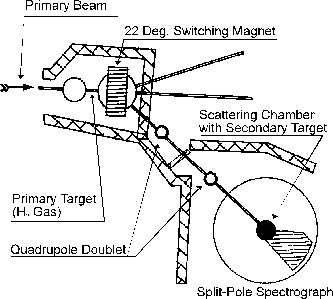
Design of the 17F Production Target
The 17F production target must be capable of sustaining an 17O beam current of as much as one particle mA and have an effective thickness of at least 250 mg/cm2, in order to obtain more than 105 particles per second on the secondary target given the 17F production cross-section [4] in the order of 10 to 100 mb and a transport efficiency of about one percent.
Experience indicates that foil (CH2) targets
cannot take the necessary high beam current, even in rapid rotation.
Therefore, a gas target with an effective length of 7.5cm and
thin HAVAR [5,6] windows was chosen [see Fig. 2.]. To keep the
temperature of both the windows and the hydrogen gas low, the
chamber has double walls to accomodate a constantly flowing cooling
liquid in the outer cylinder. Four support pipes supply cooling
fluid and H2 gas.
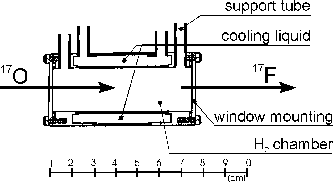
The selection of window material and thickness was made as a compromise between the maximum sustainable gas pressure and the deleterious effect of thick windows on angular and energy straggling. The effect on the energy spread is negligible, since usually the reaction kinematics dominates this even near the reaction threshold. On the other hand, the contribution of the small-angle scattering to the beam divergence can dominate the effective beam emittance. The required energy on the secondary target led to reaction energies between 73 to 77 MeV (threshold at 63.8 MeV) resulting in an maximum divergence of ±1.5° from kinematics (average of about ±1°). This relatively small cone is due to the negative Q-value of p(17O, 17F)n. A reaction with a positive Q-value would result in a much larger angular spread.
For two 1.9 mg/cm2 HAVAR windows, the small angle scattering is also of the order of ±1°, which made this type of window a good choice. Glued in a mounting ring with an inner diameter of 1.27 cm, they withstood a 250 pnA beam of 83 MeV 17O at H2 pressures up to of 460 Torr. A higher pressure was not tested.
The divergence and energy width of the 17F
is estimated to be ±1.6° and ±4 MeV from the combined
contribution of all effects. Calculations of the beam optics and
examination of the windows after the run suggest a beam spot radius
of 2 mm on the entrance windows. This makes a spot with a 3 mm
radius on the exit windows. From this, we estimate the unnormalized
emittance of the secondary 17F to be 84 p·mm·mrad.
Transport of the 17F beam to the secondary target
The program TRANSPORT [7] was used to calculate the
beam optics of the 17F and predict a transport efficiency.
For such a large emittance beam, a transmission of 3.5% is predicted,
assuming a uniform density profile. Using a peaked density profile
increases this number by a factor of 2. It is also estimated that
35% [8] of the 17F beam is in the 9+ charge
state, resulting in another attenuation factor of 3. The calculated
beam envelope is shown in Fig. 3. and compared to mechanical apertures
in the system.
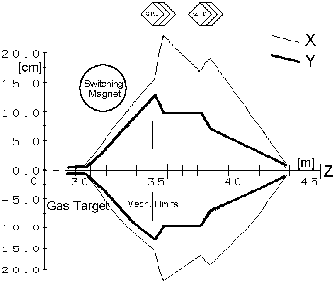
Both energetic and angular distributions of the 17F
beam are strongly affected by the reaction kinematics. Therefore,
a correlation between energy and angle of a particle is to be
expected. These correlations are not included in the TRANSPORT
studies and place significant uncertainties on the predicted transmission.
However, this simple model leads to an expected overall efficiency
of 1 to 2%.
At a primary beam of 250 pnA 17O, one expects a 17F production rate of 2·107 per second. At the spectrograph, a 17F current of 1·105 per second was observed. The upper limit of the vertical spot size on the secondary target is calculated to be 1cm. The y-magnification of the spectrograph is three, and so the detector [9] in the spectrograph focal plane is unable to intercept all beam particles. We estimate a detection efficiency of only 50% due to this effect, resulting in a transport efficiency of 1%, in reasonable agreement with the estimate in the last paragraph.
The ratio of 17F particles to other nuclei
detected in the focal plane of the spectrograph in the experiment
was better than 3:1, in a measurement taken at 0° and therefore
with a much weaker primary 17O beam of only 175ppA
on the gas target [See Fig. 4].
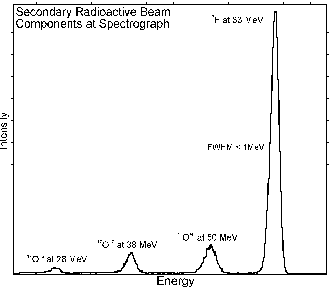
The goal of the experiment was to detect 14O
nuclei from 17F(p,a)14O
in inverse kinematics. To provide easy discrimination between
14O nuclei and background, the a
particle was detected in coincidence in a silicon detector. While
the spectrograph covered 2° to 10° on the left side
of the beam, the alpha detector measured a-particles
on the right side between 6° and 20°. In the coincidence
spectrum, the 14O particles are the most prominent
group [see Fig. 5]. The 17F and 17O particles
scattered in the spectrograph are only in random coincidence with
uncorrelated particles in the silicon detector.
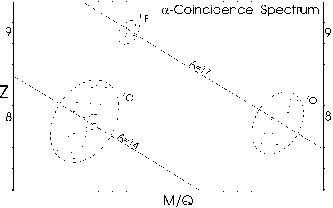
By slightly changing the field of the 22° switching
magnet, a certain energy control of the secondary beam was available
without retuning the accelerator. Due to the large energy spread
in the 17F particles, the current of the secondary
beam did not change more than 50% when swept over a 2 MeV energy
region.
This first experiment with a radioactive 17F-beam shows that a gas target can be used to produce a radioactive beam from a stable beam in flight. However, it is difficult to transport the secondary beam, and the accessible energy range is restricted by the cross-section and the reaction kinematics. Nevertheless, the technique works well, producing on the order of a few 105 particles per second. With this radioactive beam, it is already possible to measure an astrophysically significant nuclear reaction cross section.
To gain a larger range of accessible energies, to uncouple the production reaction energy from the energy of the secondary beam, and to reduce the energy spread of the secondary beam, the production target has to be moved in front of active elements of the accelerator system. A strong focusing element, directly after the gas target also improves the overall transport efficiency. However, the acceptance of the rest of the beam transport system limits this effect.
Testing different production target locations and
the refinement of the gas target itself are the next steps in
the development of this in-beam production of radioactive beams
at ATLAS..
This work was supported by the US D.O.E., Nuclear Science Division, under contract No. W-31-109-ENG-38.
Boris Harss is a student of Prof. H.J. Körner
at the Institute for Nuclear Physics and Nuclear Solid State Physics
E12, Technische Universität München, working on this
project in partial fulfillment for a diploma thesis.
[1] L.M. Bollinger, et al., Nucl. Inst. and Meth. A328, (1993) 211.
[2] R.Coszach, et al., Phys. Lett. B353, (1995) 184.
[3] A.D.Roberts, et al., Nucl. Inst. and Meth., B103 (1995) 523.
[4] J.K.Blair, Phys. Rev. C8, (1), (1973) 120.
[5] L.S. Skaggs, et al., Proc. of the World Conf. of the Internatzional Nucl. Target Development Society, Bosten, MA, USA (1979) 249.
[6] J.D. Carlson, Nucl. Inst. and Meth. 113 (1973) 541.
[7] K.L. Brown, Advances Particle Phys. 1, (1967) 71.
[8] K.Shima, et al., Atomic Data and Nuc. Data Tables, 34 (3) (1986) 358.
[9] K.E.Rehm, F.L.H. Wolfs, Nucl. Inst. and Meth., A273 (1988) 262.